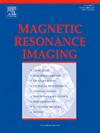传统扩散加权成像与多路灵敏度编码结合深度学习重建在乳腺磁共振成像中的比较。
IF 2.1
4区 医学
Q2 RADIOLOGY, NUCLEAR MEDICINE & MEDICAL IMAGING
引用次数: 0
摘要
目的:评价多重灵敏度编码(MUSE)结合深度学习重建(DLR)用于乳腺成像的可行性,并与常规弥散加权成像(DWI)和单纯MUSE进行比较。方法:本研究采用2023年6月至12月接受乳腺磁共振成像(MRI)的女性参与者的常规单次DWI和MUSE数据进行研究。采用常规重构和DLR对MUSE中的k空间数据进行重构。由两名经验丰富的放射科医师对DWI、MUSE和MUSE- dlr图像进行定量分析,获取病变与正常组织的信噪比(SNR)和对比噪声比(CNR),并采用5点Likert量表对图像质量进行定性分析。使用类内相关系数(ICC)评估读者间一致性。使用Friedman检验比较三种序列之间的图像评分、SNR、CNR和表观扩散系数(ADC)测量值,其显著性定义为P 结果:在使用三种序列对51名女性参与者的图像进行评估时,两位放射科医生表现出良好的一致性(ICC = 0.540-1.000,P 结论:与传统DWI相比,MUSE-DLR获得的图像质量得到改善,仅需要稍长的采集时间。本文章由计算机程序翻译,如有差异,请以英文原文为准。
Comparison of conventional diffusion-weighted imaging and multiplexed sensitivity-encoding combined with deep learning-based reconstruction in breast magnetic resonance imaging
Purpose
To evaluate the feasibility of multiplexed sensitivity-encoding (MUSE) with deep learning-based reconstruction (DLR) for breast imaging in comparison with conventional diffusion-weighted imaging (DWI) and MUSE alone.
Methods
This study was conducted using conventional single-shot DWI and MUSE data of female participants who underwent breast magnetic resonance imaging (MRI) from June to December 2023. The k-space data in MUSE were reconstructed using both conventional reconstruction and DLR. Two experienced radiologists conducted quantitative analyses of DWI, MUSE, and MUSE-DLR images by obtaining the signal-to-noise ratio (SNR) and the contrast-to-noise ratio (CNR) of lesions and normal tissue and qualitative analyses by using a 5-point Likert scale to assess the image quality. Inter-reader agreement was assessed using the intraclass correlation coefficient (ICC). Image scores, SNR, CNR, and apparent diffusion coefficient (ADC) measurements among the three sequences were compared using the Friedman test, with significance defined at P < 0.05.
Results
In evaluations of the images of 51 female participants using the three sequences, the two radiologists exhibited good agreement (ICC = 0.540–1.000, P < 0.05). MUSE-DLR showed significantly better SNR than MUSE (P < 0.001), while the ADC values within lesions and tissues did not differ significantly among the three sequences (P = 0.924, P = 0.636, respectively). In the subjective assessments, MUSE and MUSE-DLR scored significantly higher than conventional DWI in overall image quality, geometric distortion and axillary lymph node (P < 0.001).
Conclusion
In comparison with conventional DWI, MUSE-DLR yielded improved image quality with only a slightly longer acquisition time.
求助全文
通过发布文献求助,成功后即可免费获取论文全文。
去求助
来源期刊

Magnetic resonance imaging
医学-核医学
CiteScore
4.70
自引率
4.00%
发文量
194
审稿时长
83 days
期刊介绍:
Magnetic Resonance Imaging (MRI) is the first international multidisciplinary journal encompassing physical, life, and clinical science investigations as they relate to the development and use of magnetic resonance imaging. MRI is dedicated to both basic research, technological innovation and applications, providing a single forum for communication among radiologists, physicists, chemists, biochemists, biologists, engineers, internists, pathologists, physiologists, computer scientists, and mathematicians.
 求助内容:
求助内容: 应助结果提醒方式:
应助结果提醒方式:


